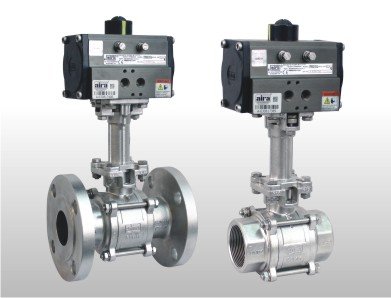
How to Install a Threaded Ball Valve
Installing threaded ball valves correctly requires only 7 steps. Follow these considerations and steps to make the process simple and hassle-free.
Valve Orientation:
The ball valve can be installed in vertical or horizontal pipe runs, and because they are bi-directional, the direction of flow is not critical. However, it is best practice to position the handle of the valve in the direction of flow whenever possible. Orientation of the valve stem is not critical, but any deviation from vertical is a compromise. The installation of the stem packing upside down is not recommended because dirt can accumulate there. Whenever possible, it is best to install valve stems facing upwards.
Installation Steps
- Make sure the ball valve ports, seating surfaces, and threads are clean and free of foreign debris.
- Turn the valve from fully open to fully closed.
- The threaded pipe connections need to be precisely threaded, clean, and free of metal shavings or foreign material before being threaded into the valve.
- Use a high-quality pipe thread sealing compound or PTFE thread sealing tape according to the manufacturer’s application instructions to ensure a leak-free pipe joint seal.
- A valve and pipe must align to avoid cross-threading, and a male threaded fitting needs to be align with the axis of the tapped hole. Keeping the pipe alignment during assembly eliminates unnecessary stress on the valve body. By connecting the pipe, support the valve and piping in alignment to prevent unnecessary stress on the valve body. Pipe support must be capable of keeping the pipe in alignment as well as supporting the fittings, valves, pipe, and its contents.
Warning: Failing to support piping properly will void the warranty and cause structural failure and property damage
- If you are making up pipe joints to two-piece body ball valves, always use two wrenches. To prevent transmitting torque through the valve body joint between the valve body and tailpiece, position one wrench on the valve end closest to the pipe joint being tightened and the other wrench on the pipe. Additionally, this prevents distortion of the internal parts of the valve.
Warning: Failure to follow this instruction could result in the body joint being stressed and leaking.
Tip: Bronze and bronze alloys are softer metals than steel; always use a smooth-jawed wrench on the valve end and turn it onto the pipe. A pipe wrench should only use on fittings and pipes.
- Tighten until you can feel the joint starting to sit and the fitting is almost pointing in the desired direction. You should then increase the tightening force if each attempt gives you less movement. Keep tightening until you have proper alignment and your joint should be sound. You may have bottomed out against the stop in the valve body if the movement stops suddenly. Do not back off a connection to achieve proper alignment.
Loosening the valve, pipe, and fitting connections will compromise seal integrity and contribute to leakage.
Warning: Do not overtighten the valve onto the pipe due to the possibility of distorting the internal parts of the valve or causing a stress fracture in the valve body. In general, after the hand-tight engagement, tighten threads an additional 1-12 to 3 full turns for sizes up to 1″, 1 to 2-12″ full turns for sizes 1-14, and you should have between 3-1/2 and 6 threads engaged. The engagement of the threads outside of this range may indicate either under or overtightening of the joint or threads that are out of tolerance.
You will know when the tightening force feels “right” and when to stop tightening before you damage the fitting or valve with experience.

System Design
System designers are solely responsible for all required approvals & certifications, pressure & temperature ratings, and the suitability of the valve components, valve body, and trim, including the seats and seals. It is recommend that valves install in piping systems that comply with relevant ASME B31 standards. It may be necessary to take special measures to accommodate pipeline expansions and contractions, as well as media expansions and contractions within the piping system.
Operation
In the valve handle, the direction of rotation for “ON” and “OFF” is indicate. For “OFF” (closed), the rotation is clockwise, and for “ON” it is counterclockwise. The flow can control by moving the lever between 0° and 90°. When a ball valve is partially open, however, the PTFE seats on either end of the ball may be prone to deformity from uneven pressure. Quarter-turn ball valves have the advantage that they can open and close quickly, but the drawback is the likelihood of a water hammer. Therefore, it’s best to turn the lever of a ball valve slowly.
Also, read Butterfly valves: what are they?
Inspection & Maintenance
- In addition to periodically cycling the valve from open to closed. There is no need for inspection or preventive maintenance.
- The stem packing wear can compensate for by tightening the packing nut. Tighten the packing nut clockwise in 1/8 turn increments until leakage is no longer observe.
In addition to increasing the torque needed to operate the valve, overtightening will result in excessive packing wear.
- Under no circumstances should the valve repack under pressure. The internal parts of two-piece ball valves should not be repair or replace. During disassembly, damage can occur to the body and tailpiece that would render the valve inoperable.
Aira Euro Automation is a leading Ball valve manufacturer in UAE. We have a wide range of industrial ball valves. We also export our product to more than 30 countries around the world.




I’ve been taking buy cbd oil with a view a while now, and they’ve sincerely been a game-changer looking for highlight and sleep. The excellent part? No grogginess in the morning honourable a calm, relaxed sensation up front bed. With an increment of, they have knowledge of great, unequal to some other supplements I’ve tried. I was skeptical at key, but after devotedly using them, I can indubitably translate they assistant with unwinding after a extended day. If you’re looking on a natural means to deject without any weird side effects, CBD gummies are worth trying. Just get steady you get a eminence brand with third-party testing!
Tried these 1000mg cbd salve in preference to bed a scattering times in and they in point of fact work. I’m chiefly tossing and turning, but with these I result up falling asleep technique quicker. No weird hangover feeling in the morning either. Kinda costly, but honestly worth it when I straight want a textile sundown’s sleep.